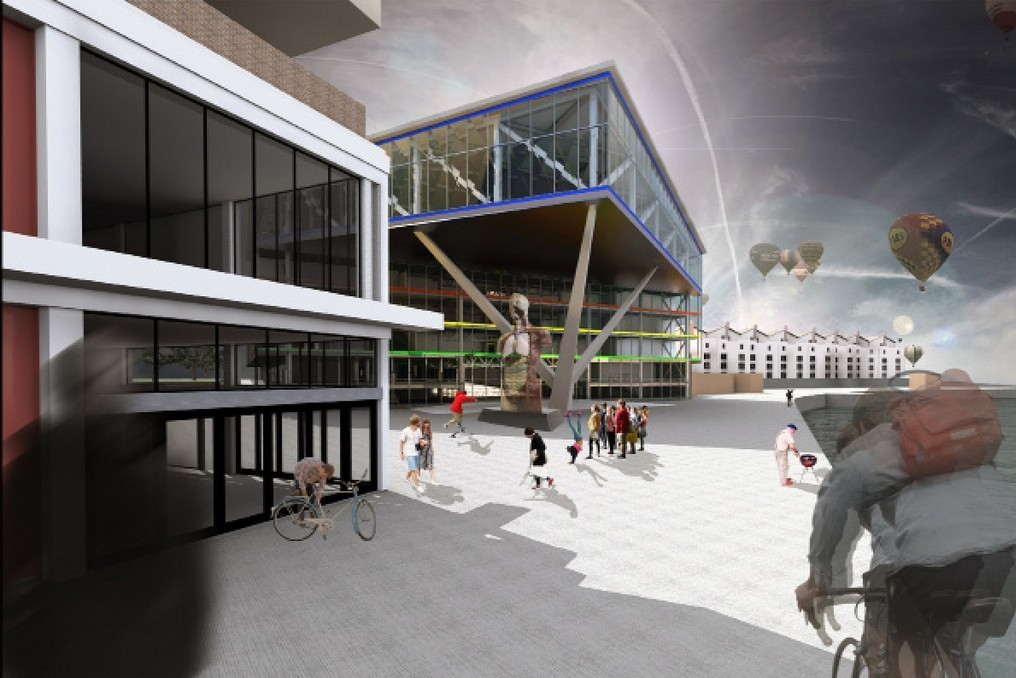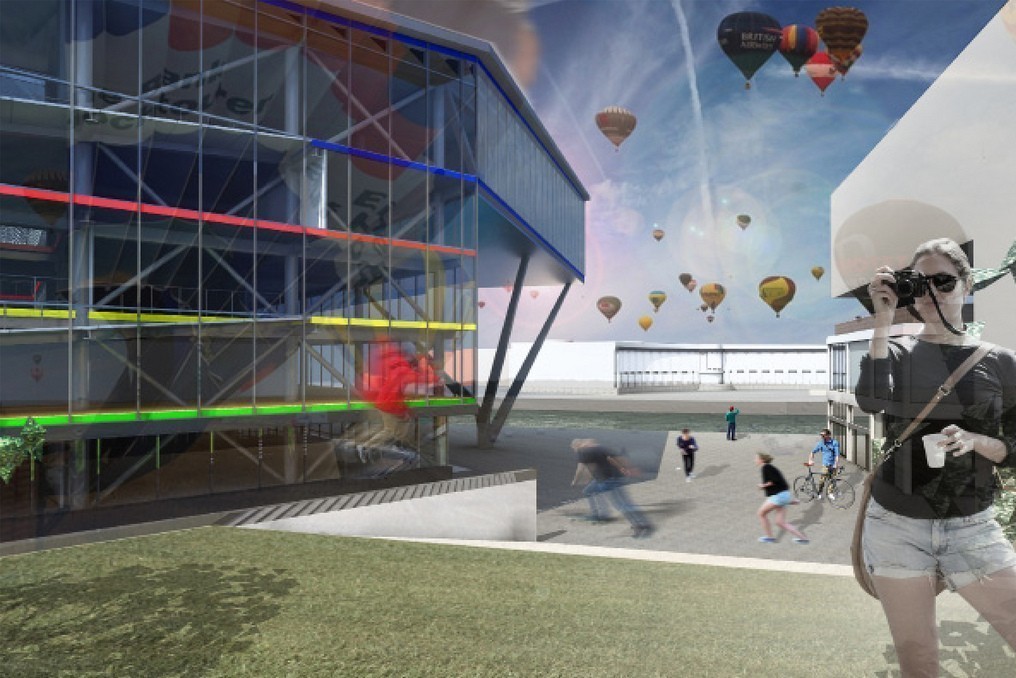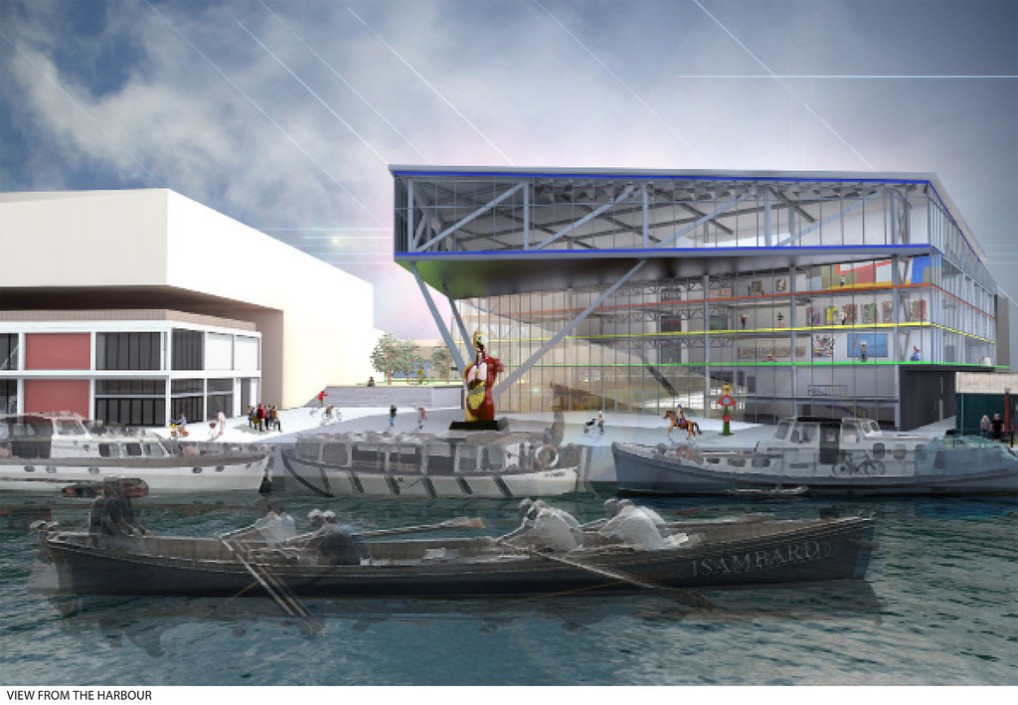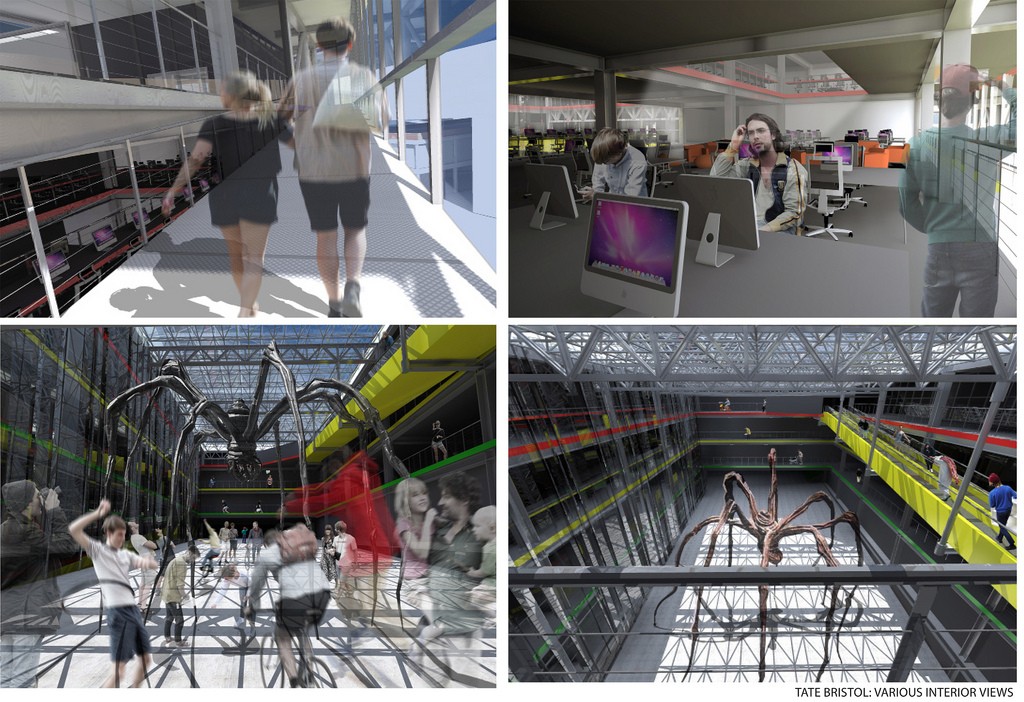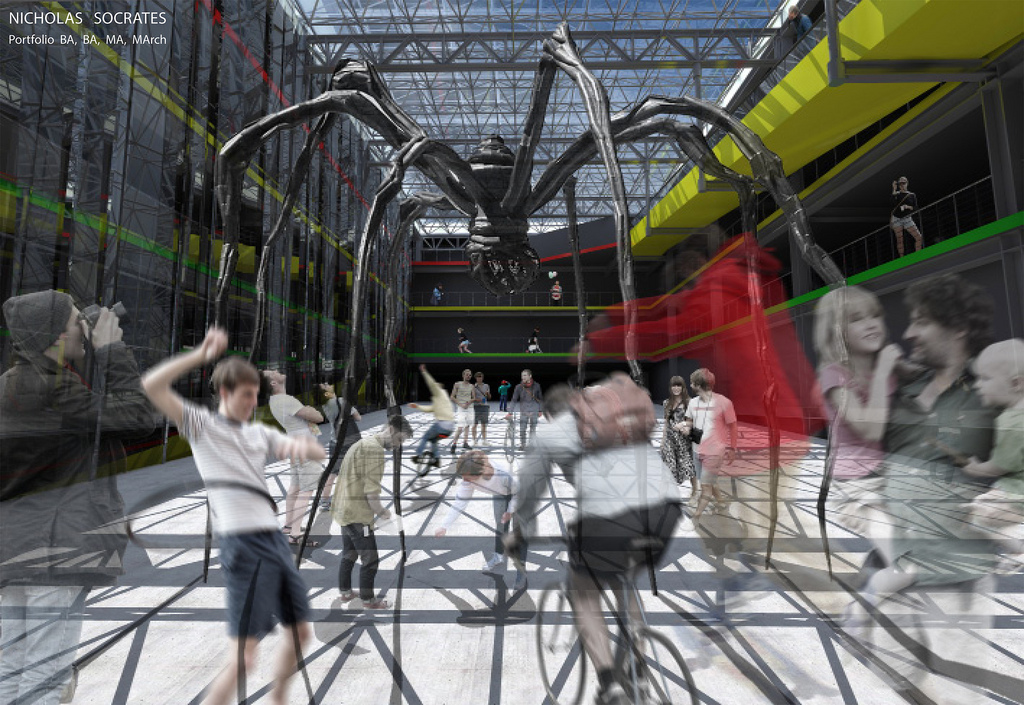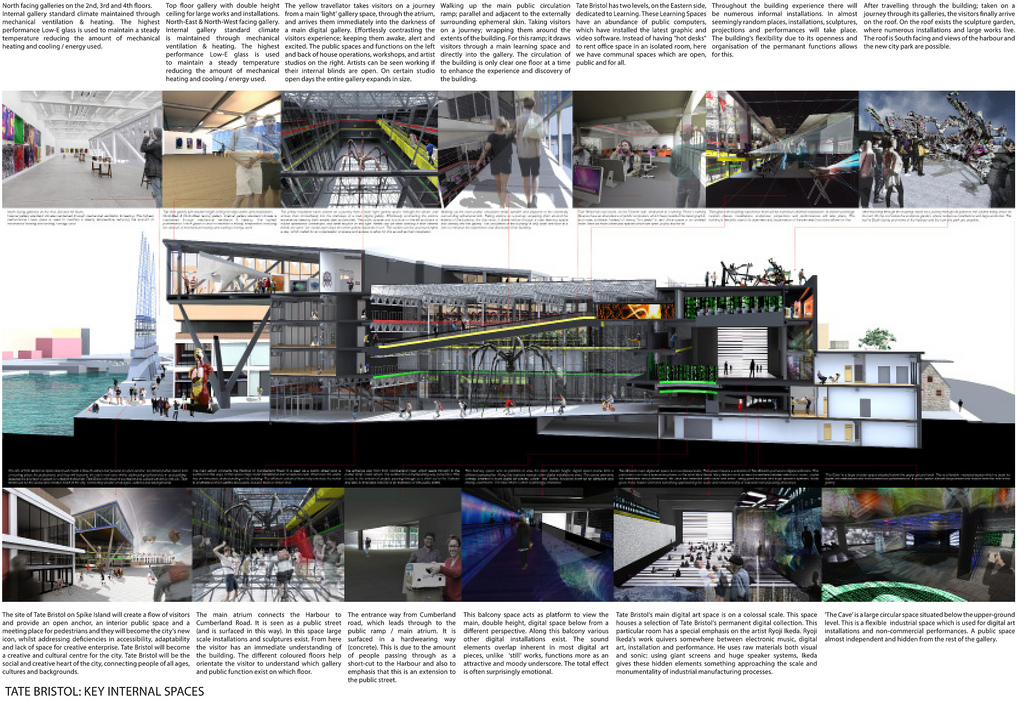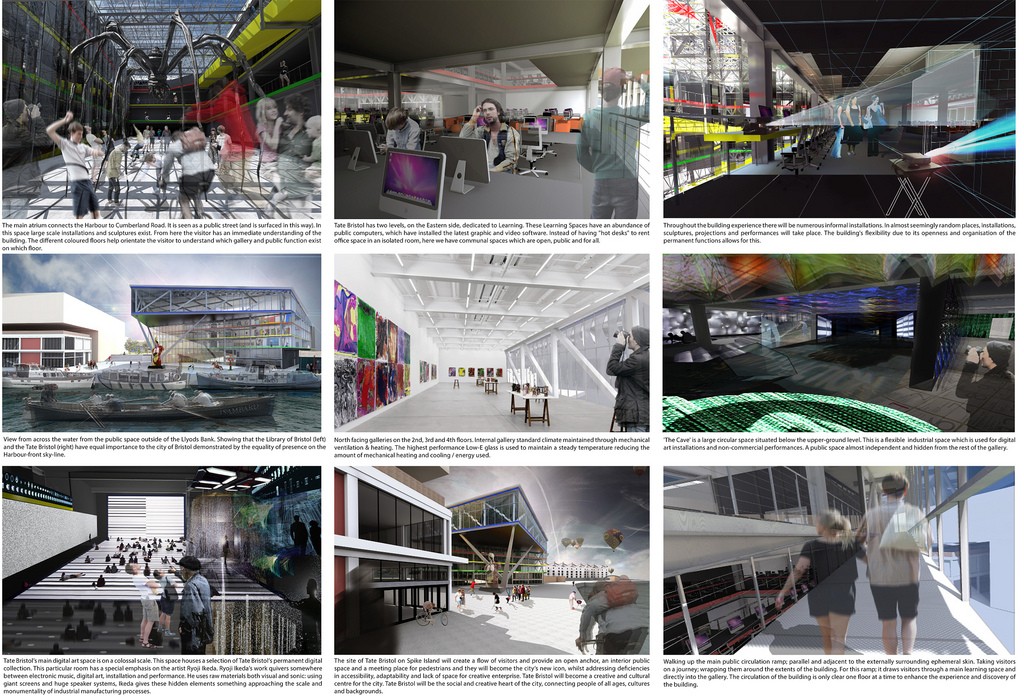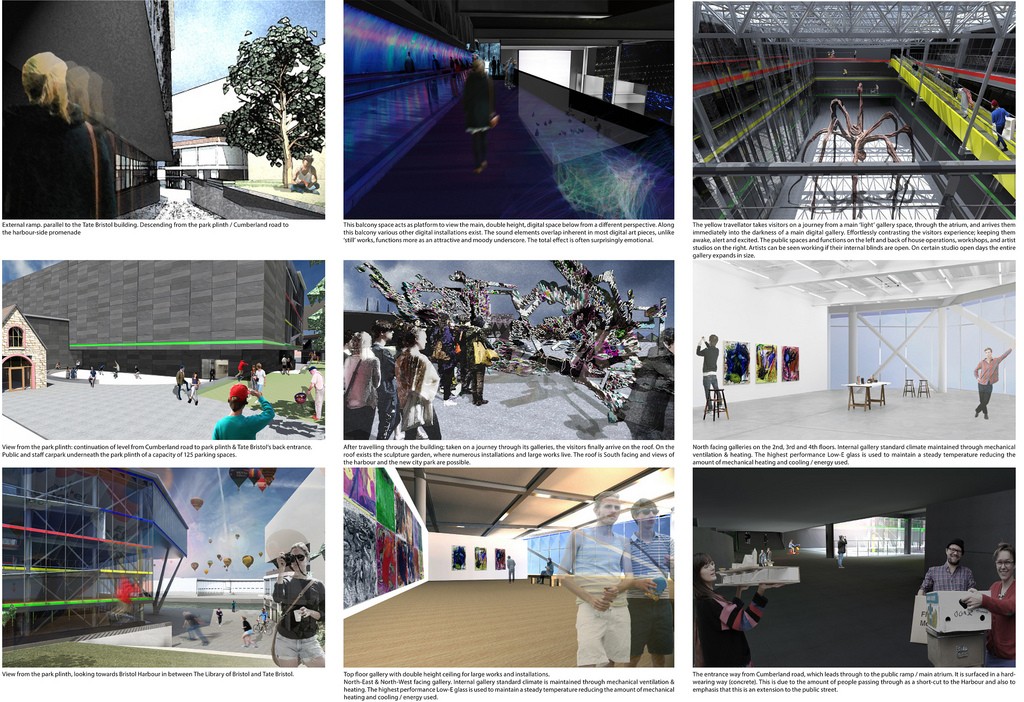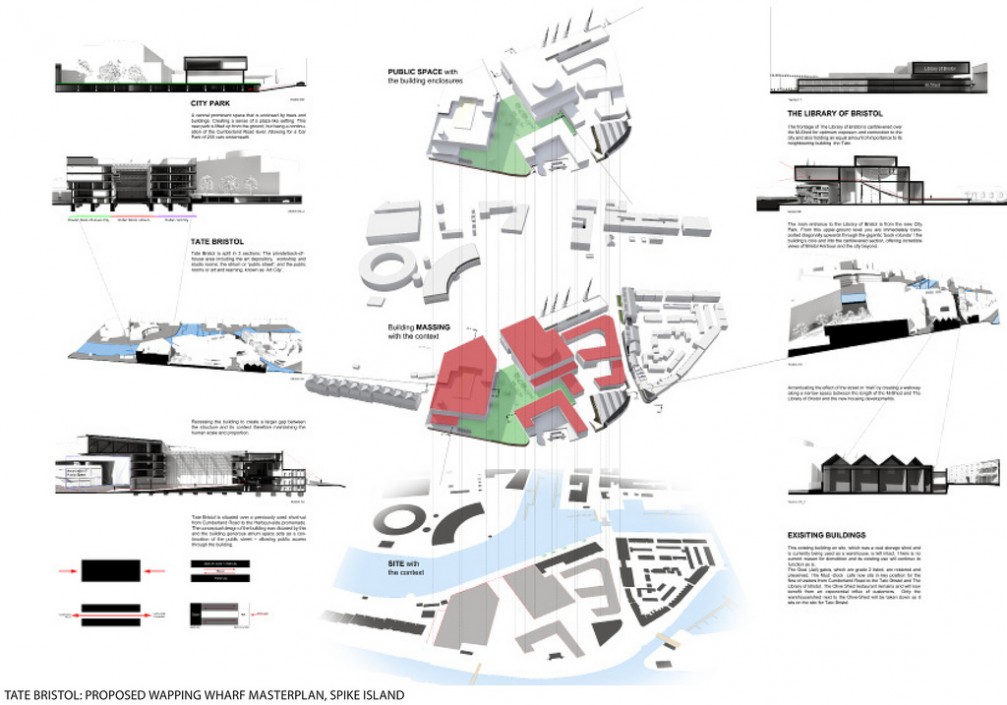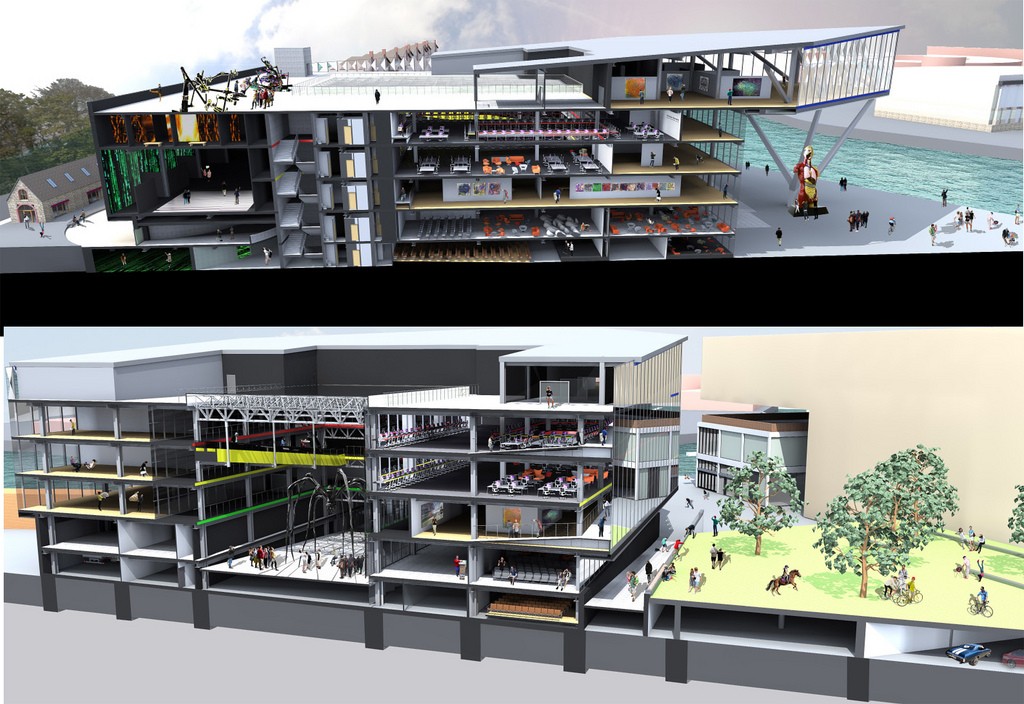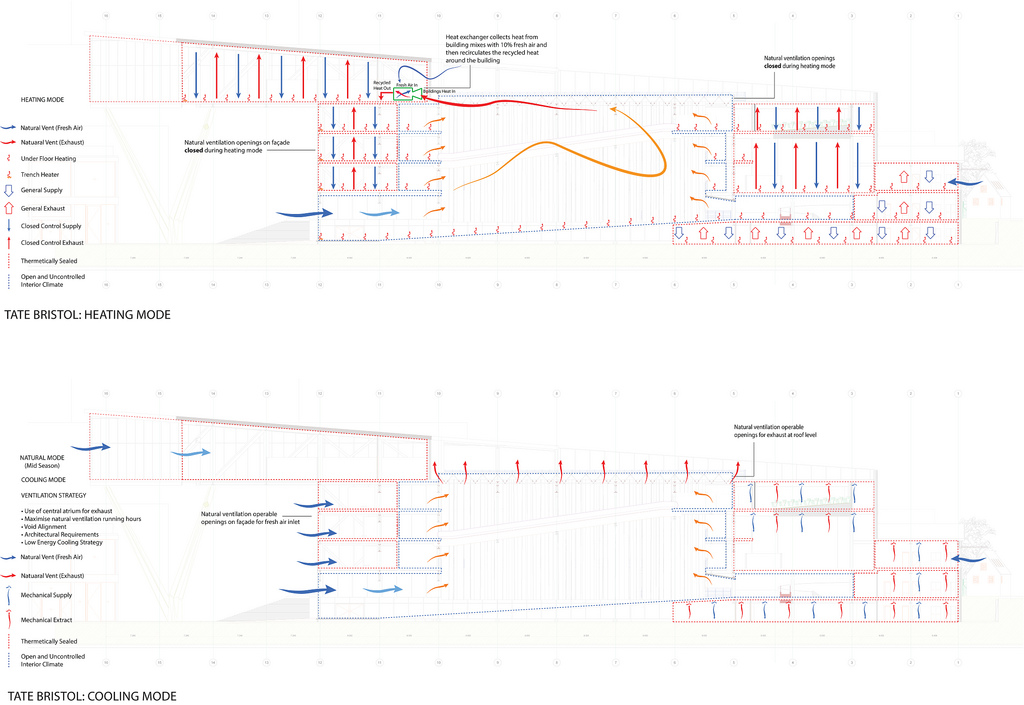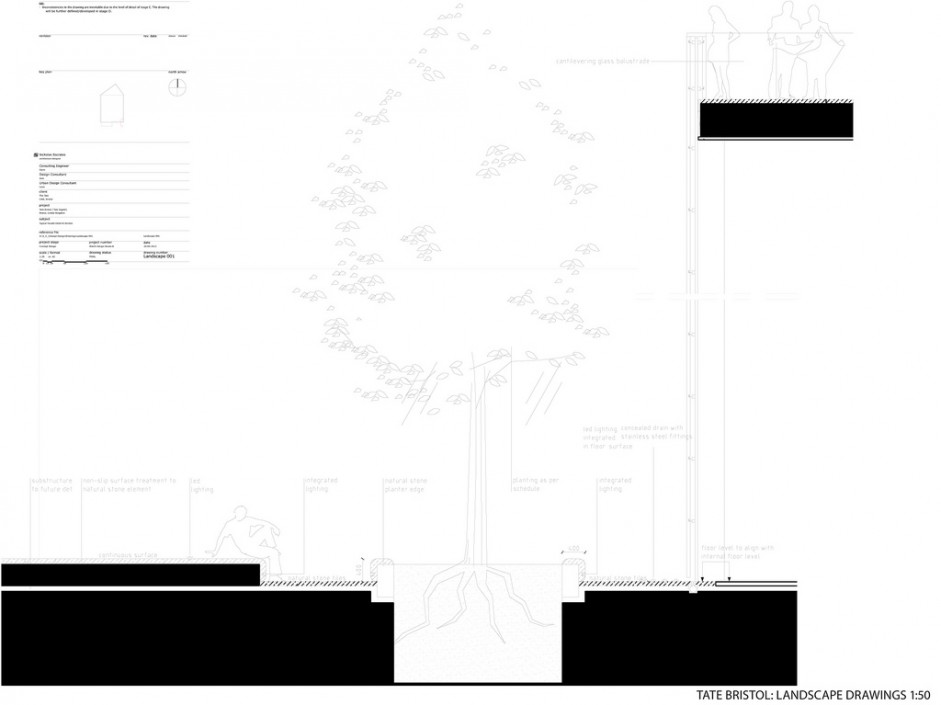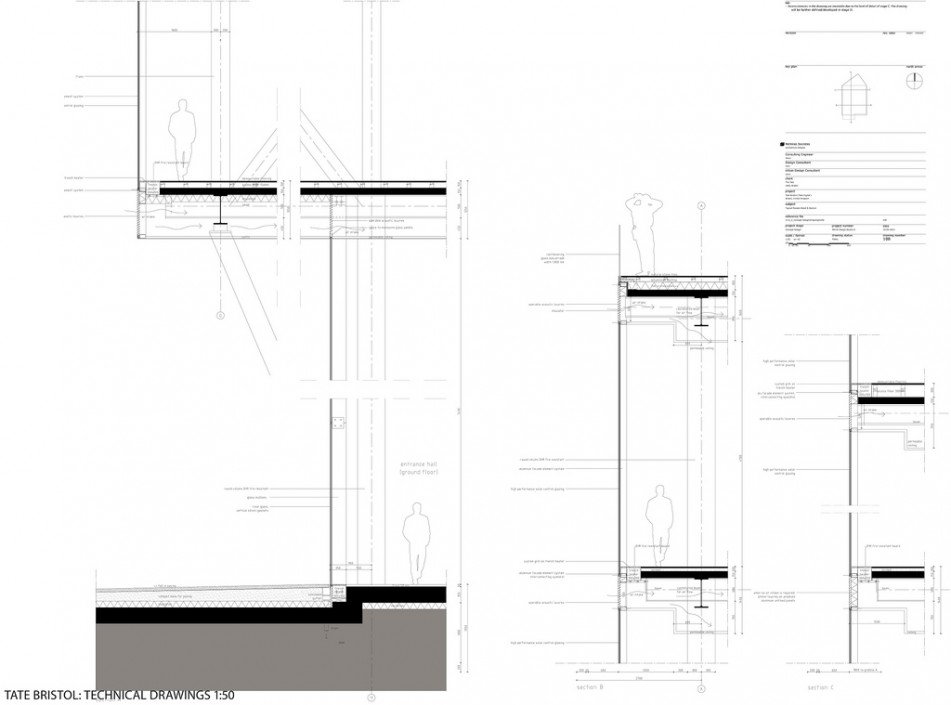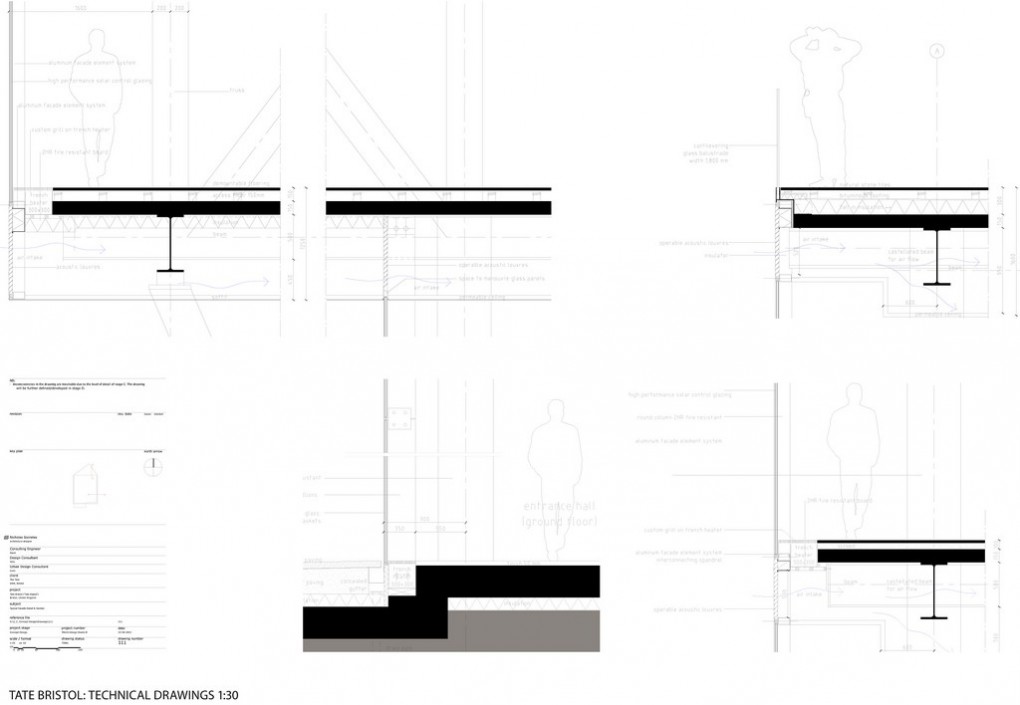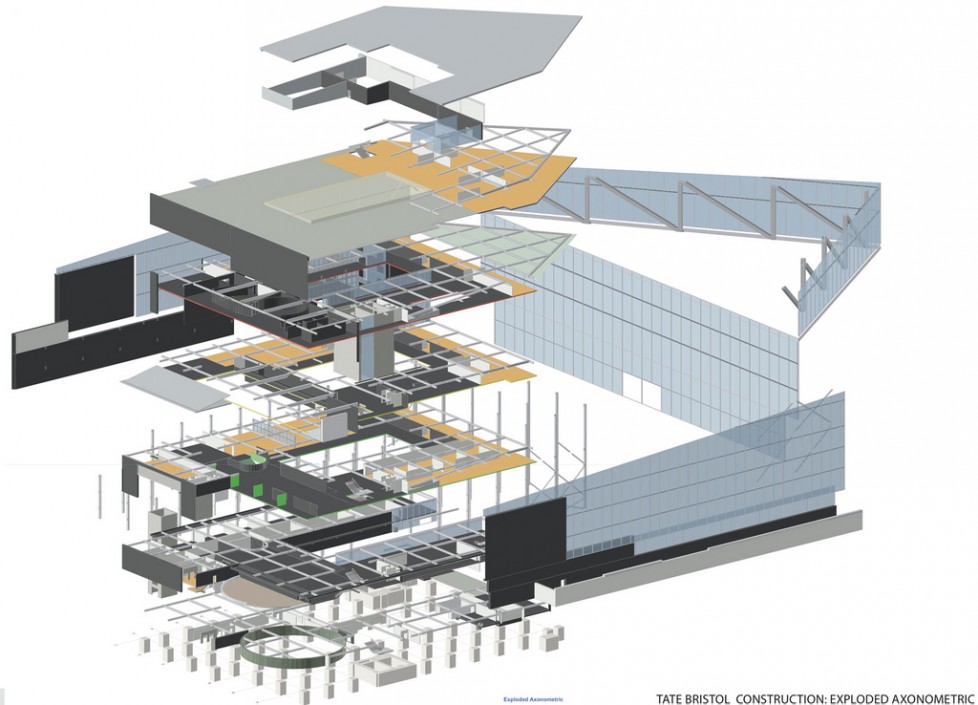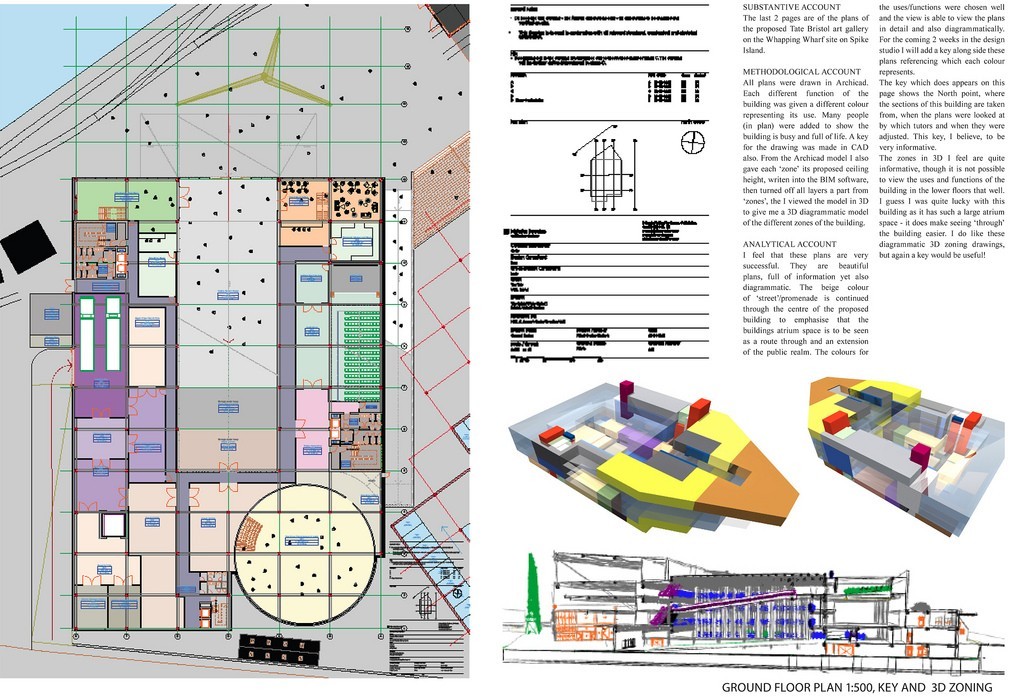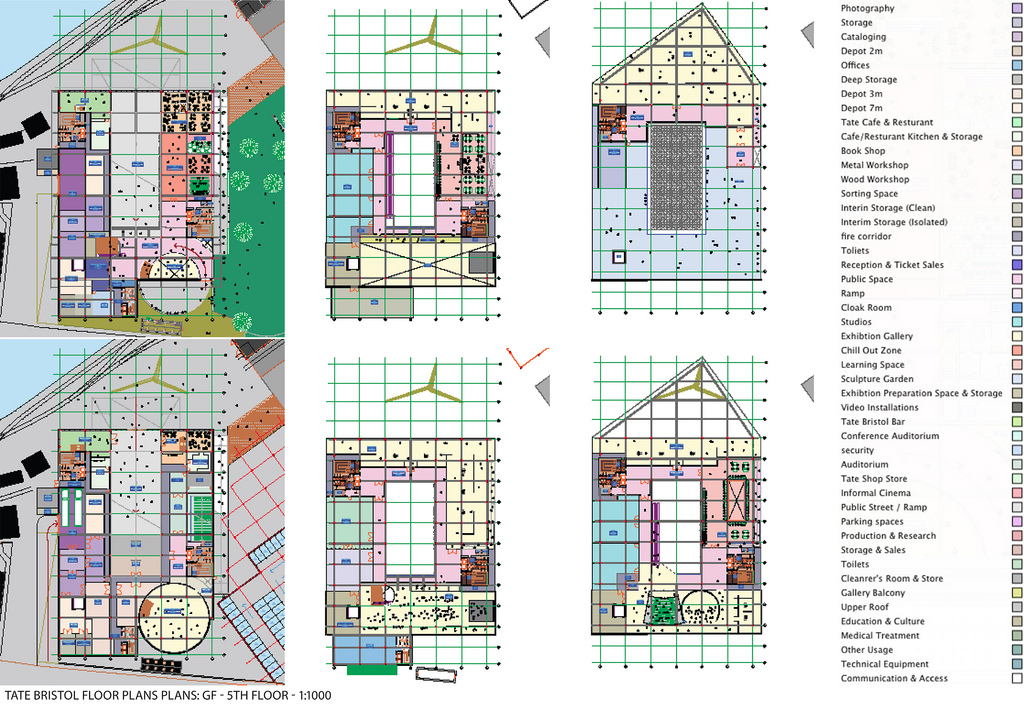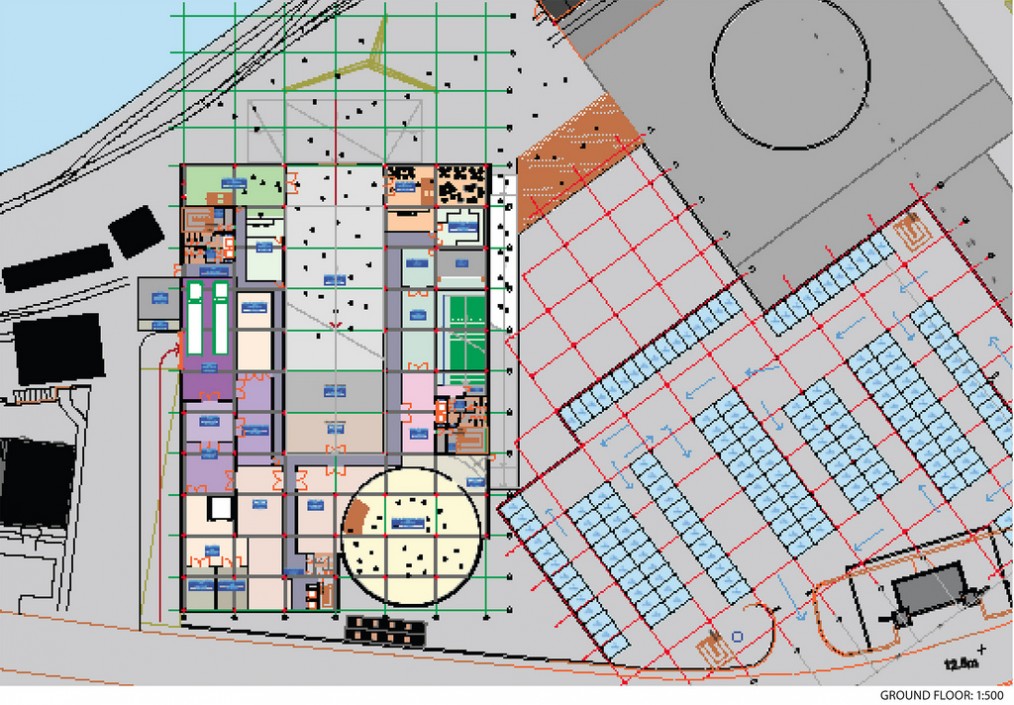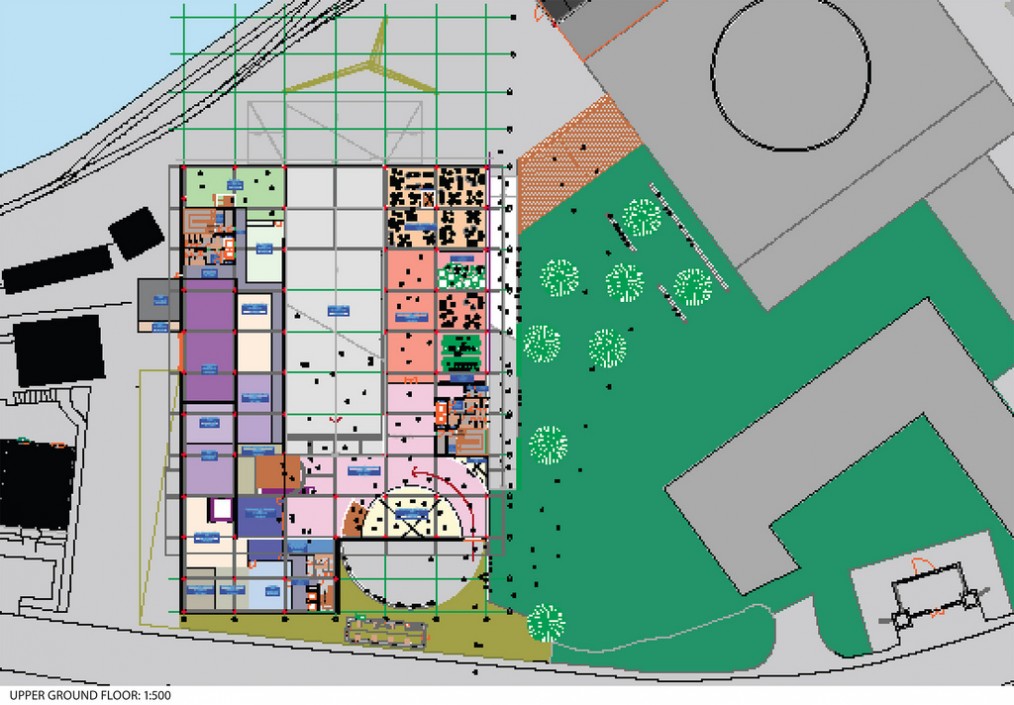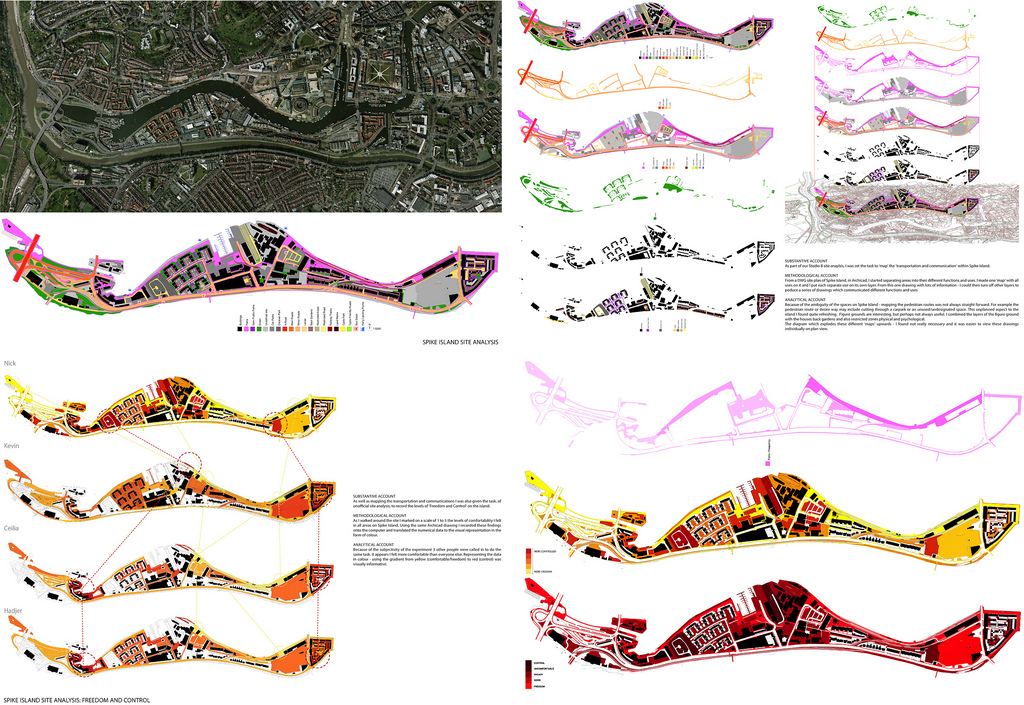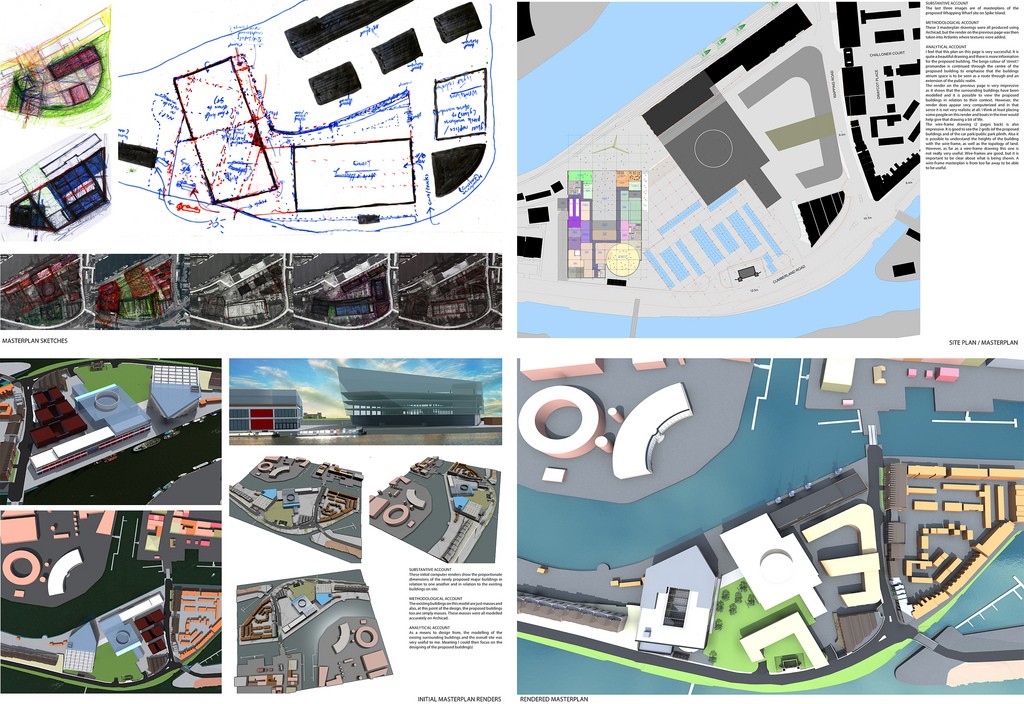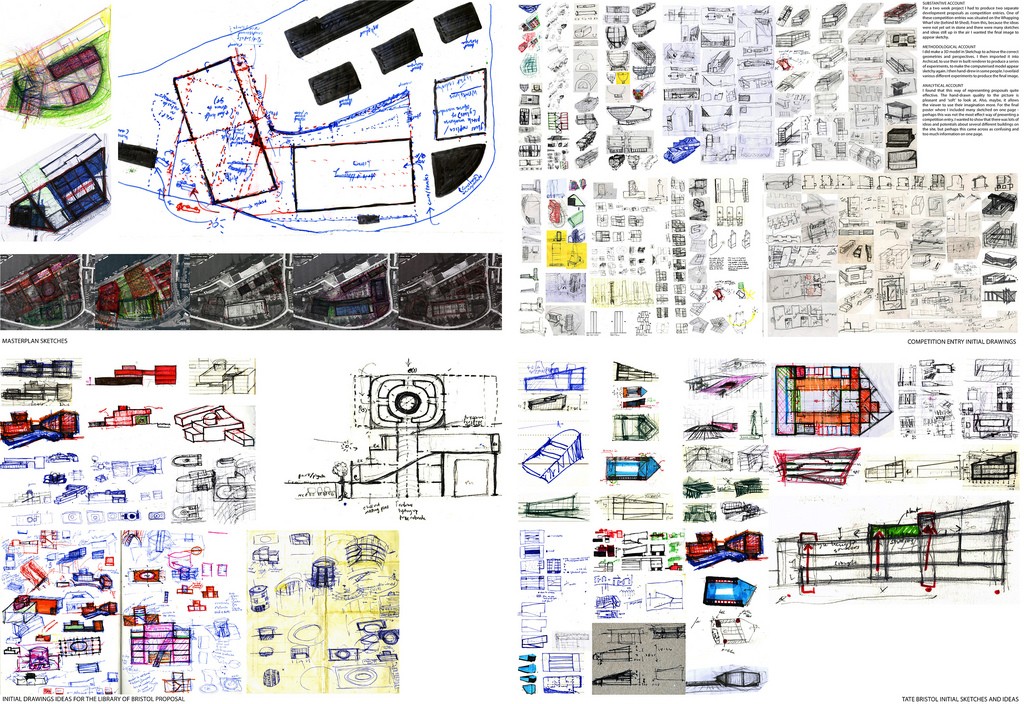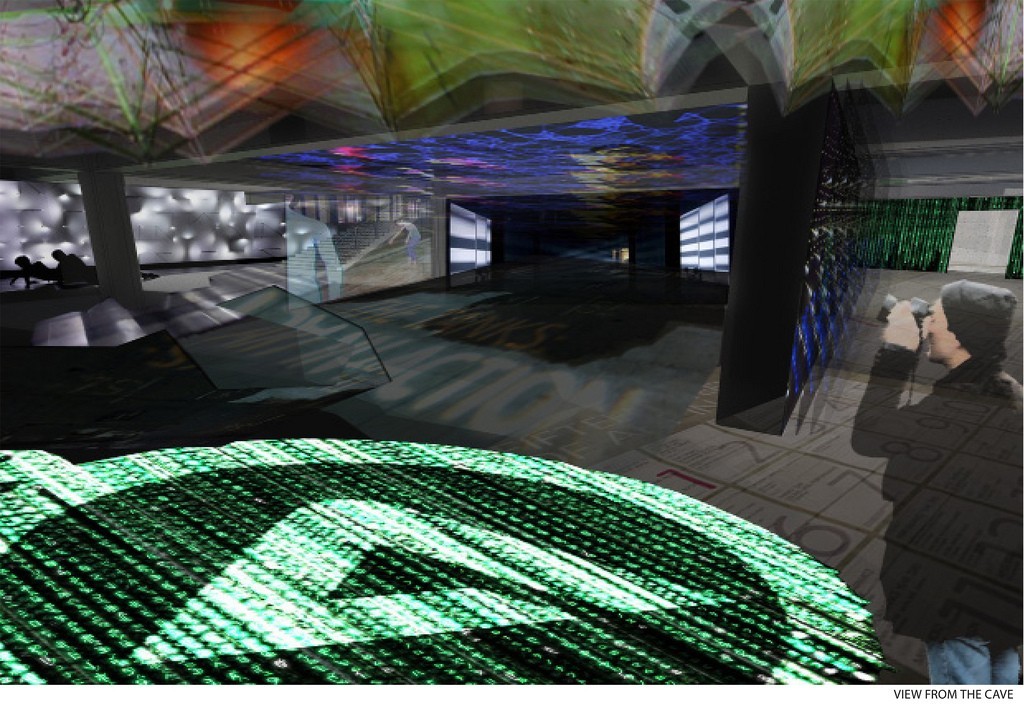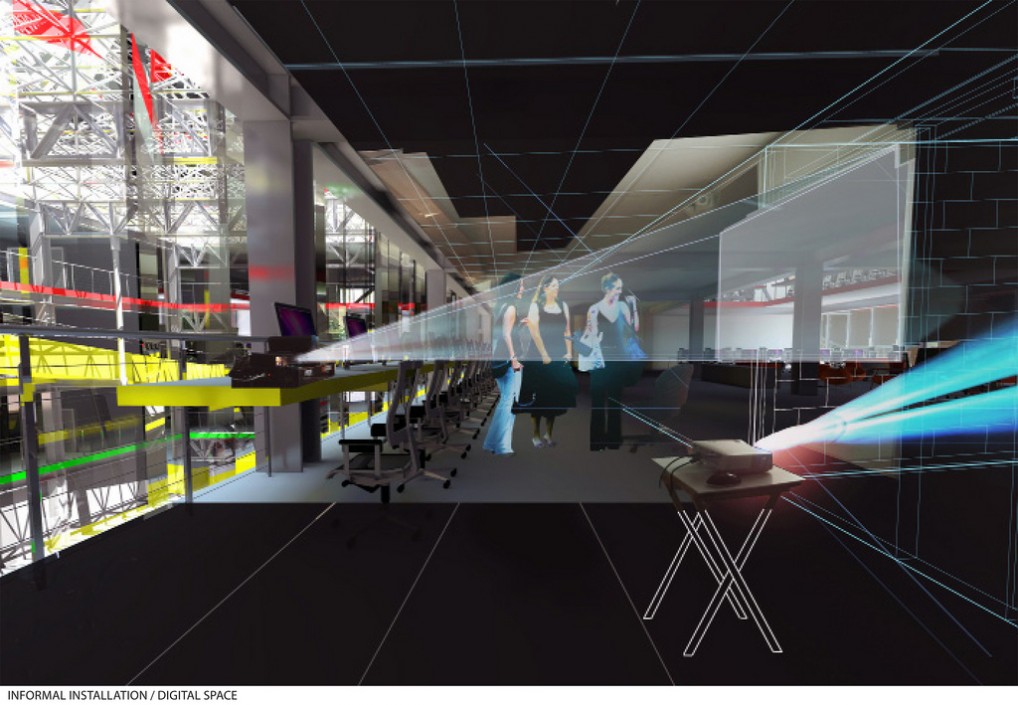Tate Bristol – direct proposal
1.1 The Project
Tate Bristol brings the art world together to inspire creativity and discovery’.
Tate Bristol will not only be one of the art galleries in the United Kingdom, but it will also aspire to be a major catalyst for the regeneration of the city of Bristol.
1.2 About the Design Brief
The most appropriate time for major decisions in building projects is in the pre-design stage, at the very beginning of a project. At this stage the range of options is still extensive and decisions and changes to requirements do not yet have costly consequences. It is recognised that at the early stages of the project a shortfall of information means that it can be difficult to make lasting decisions. It is also important to underline that this can lead to delays well into the design and construction stages. When design and construction begin, decision possibilities and changes become more restrictive, tend to be more costly, also in terms of time, and can lead to unsatisfactory solutions.
Establishing a comprehensive Design Brief in the pre-design stage helps to increase the level of information and knowledge, well before the commencement of the actual design work. The main purpose of this detailed Design Brief, is to map, describe and distil the ambitions and aspirations of the various stakeholders that form the Client body into a foundation for all further decision-making, design work and approvals.
Essential project knowledge consists not merely of information supplied by me (the architect), but also knowledge held by the staff and designated users of the future building. This information includes work styles, processes and the resulting spatial requirements. Staff knowledge of the day-to-day working processes is also an essential contribution to understanding the functional requirements. The Design Brief is a result of close cooperation with those individuals, at the existing Tate galleries around the UK (in London: Tate Modern and Tate Britain, Tate Liverpool and Tate St. Ives). Through a series of interviews and meetings I have acquired detailed information about the project. At this stage, the Design Brief has identified various competing pressures and aspirations that will require further resolution. Under these conditions this Design Brief of February 2013 it cannot not be viewed as a definitive document, but rather as an on-going part of the design development. It therefore allows for small modifications and some additional elaboration within the stated framework. In order to reach the highest level of aspirations for this project it must be recognised that a level of managed flexibility will be of key importance.
1.2.1 Centre of Diversity
The design of Tate Bristol, must grow out of the multi-ethnic and cultural diversity of Bristol, promoting understanding and community confidence. The city will become a part of Tate Bristol, and Tate Bristol a part of the city. The qualities of Tate Bristol should be self-evident for everyone. Tate Bristol must represent the social heart of the Bristol citizens. Tate Bristol should be advanced both technologically and functionally; it will offer maximum diversity. The experience should be surprising and inspiring. This needs to be reflected in bi-monthly programming of Tate Bristol. The building should be easily accessible for adults but especially for young people and children. Tate Bristol will be egalitarian, fostering the inclusion of the widest possible audience.
The site of Tate Bristol on Spike Island will create a flow of visitors and provide an open anchor, an interior public space and a meeting place for pedestrians and they will become the city’s new icon, whilst addressing deficiencies in accessibility, adaptability and lack of space for creative enterprise. Tate Bristol will become a creative and cultural centre for the city.
2 Vision
1 Simply Stated: The Best UK Art Gallery outside of London’
The Tate’s mission is to deliver the best art gallery in the UK outside of London. A gallery that will be an asset to the City of Bristol and attract visitors and users both locally and nationwide. Bristol has had many identities in its lifetime and is currently re-charting its path to become a cultural based, creative city: one that brings together people from all over the UK to change lives by enriching them culturally and creatively. This creative-based economy will be fuelled by its own citizens, and as a result of Bristol ’s investment in providing the training and guidance necessary to enter the culture and creative workforce. Tate Bristol will be its catalyst.
Tate Bristol will be the social and creative heart of the city, connecting people of all ages, cultures and backgrounds. As a multifunctional service centre, it will appeal to a broad spectrum of people. The building will function as a core of information, art and culture centred on people and community life. It will be a supermarket of creativity and art. Tate Bristol will be a microcosm of Bristol itself, reflecting its potential economic strength and the multiple cultures of its citizens.
The fundamental objectives of Tate Bristol will be to:
Build the creative and cultural economy.
Invest in children, young people and families.
Promote community, culture and heritage.
2 Build the Creative and Cultural Economy
Bristol aspires to become a cultural city by providing extensive and unimpeded provision for creativity and the arts. Tate Bristol will provide that platform. The effects of this will be felt throughout the broader community as personal success translates into a stronger economic success for the city and the wider city region.
3 Invest in Children, Young People and Families
A core objective of Tate Bristol will be the necessity for the project to appeal to children, young people and families in every sense.
Tate Bristol will be designed to offer an adaptable service where children and young people can access resources as they make the transition to adulthood. The spaces must be designed to offer a flexible and diverse choice of learning settings and styles that are safe, welcoming and stimulating. Interactive technology will be pervasive throughout, encouraging the opportunity to explore and learn by discovery and in different ways.
The provision of informal learning environments will support parents and carers in helping their children to learn. The Children’s Area will cater to the specific needs of children and young people.
Ultimately, Tate Bristol will play a unique role in enabling children and young people to realise their full potential.
4 Promote Community Culture and Heritage
Tate Bristol will be a major new meeting place, a focal point for citizen and community activity. The design of Tate Bristol will be welcoming and inviting to all, where no barriers (attitudinal, cultural, emotional, institutional, economical, intellectual, physical or sensory) to participation can exist. It will be fully accessible to people with mobility difficulties and to people with all forms of disability.
Tate Bristol must appeal to the citizens of Bristol by instilling a sense of pride and ownership. As a significant and meaningful community space it should become a landmark that comes to define Bristol as a city. Bristol must genuinely meet the needs of the city, and its many diverse communities. The key to the future success lies in being inclusive, open and accessible. This must be a place where everyone feels they belong.
Exhibition’s taking place in Tate Bristol will include the Tate’s new interest to promote emerging artists. Many of these emerging artists will be invited to take residence in the Tate Bristol’s studios. Their work will be exhibited and in the dedicated Emerging Artists Galleries and they will continue to work on new pieces during their stay, which in turn will be exhibited again. The studio’s will be accessible to the public on specific days and will act as greater publicity for each artist. As well as Tate Bristol being dedicated to emerging talent it will also exhibit the Tate’s new and fast growing collection of Asian and African contemporary art. Also exhibitions will be curated to connect with national, regional and local cultural events.
City events such as major festivals will be supplemented by this venue. Tate Bristol will have spaces that will be programmed distributing activity over the entire day – from morning to evening. The diversity of facilities, spaces and activities will draw a diverse audience, reflecting the diversity of Bristol itself.
5.1 Community Resource
Tate Bristol will be the central point for citizen access and community participation, with the specialised support necessary to help people to realise their personal and democratic rights and aspirations. The nature of a community space should be communicated where the people of Bristol can feel ownership and pride. For all to feel welcome in the Tate Bristol, unambiguous accessibility is important. The building will be family and children friendly throughout and it will welcome young people. There can be no barriers, physical or otherwise when entering the building. The removal of all barriers to access including attitudinal, economical, cultural, emotional, institutional, intellectual and physical should be of the highest priority in order to foster and ensure the widest possible audience.
Once inside, there will be clear and immediate different functions and places where one can sit, drink a cup of coffee, view the exhibitions, hang out with friends from school.
5.2 Memory Bank
‘Without art galleries what have we? We have no past and no future.’
Tate Bristol will gather, preserve, present, exhibit and help to interpret the collective memory and identity of the city and its communities and surroundings. The rich multi-media archive and heritage resources will be accentuated through the provision of the highest quality gallery and exhibition space.
As well as exposing people to new ideas and opportunities, Tate Bristol will create memorable experiences. Through spaces that appeal to the senses, the facilities and services that Tate Bristol offer, memories will be created for generations of local people and visitors.
5.3 Cyber-entry Point
Tate Bristol will be the entry point to an array of technologies in new media and communications, disseminating knowledge and ideas that will further fuel the education of the young and the entire community at large. This will also prove that Bristol is a city on the cutting edge of technology. Technology has the potential to aid participation learning, which enhances the experience of individuals, encouraging greater self-knowledge and awareness. Touch-ability, interaction and inviting places to explore these technologies will integrate technology and human experience.
5.4 Destination for Creativity and Culture
The diversity of resources and services presented in the Tate Bristol cannot be completely understood by the term ‘gallery’. Tate Bristol is more than an art gallery alone. It will offer visitors a place for recreation and cultural expression. The diversity of services on offer means that everyone will be catered for. Tate Bristol events will take place in a multitude of spaces both inside and outside the building. The building will seamlessly merge with the urban fabric of the city. One should experience the Tate Bristol as a part of the urban promenade, a sequential walk, eventful and lengthy, but also with cross connections for easy and direct use.
5.5 Creator of Knowledge Resources
Tate Bristol will generate new forms of information in digital formats, sharing its unique collections for learning, creativity and cultural expression in innovative and imaginative ways. Tate Bristol, with its rich diversity of spaces, will foster further engagement with the available resources. The diversity of stimuli, venues and avenues for expression will mean less distinction between the consumer and producer of culture and creativity. Tate Bristol together will provide an unobstructed platform to facilitate this process.
5.6 A Promoter of Sustainability
As a city, Bristol is in an important position to demonstrate through Tate Bristol the most technologically advanced building systems and integrated sustainable principles available. Through the Tate Bristol’s own design, management and operations and through highlighting relevant global developments in its information and services, the building will exhibit the latest in sustainable technologies. Natural lighting would be provided for in both the main body of the Tate Bristol for any spaces that line the building’s perimeter. Each studio and live-in studio, for the artist’s in residence, which surround the building’s parameter, will employ natural day lighting. Operable windows at the exterior would benefit individual interior comfort by enabling natural ventilation.
Eco-technological strategies work well with more passive measures to create a dramatic structure that is both a social activator and successful precedent of sustainable practice that can allow the form of the building to remain true to the drama of its concept. The best sustainable solutions should enhance aesthetic goals, limit resource consumption, improve building performance, and promote health and productivity.
5.7 Promoter of Bristol and the Region
The building will be distinctively of Bristol, a statement of Bristol ’s global position and importance as the West of England’s capital. Tate Bristol will be a people’s palace: warm and welcoming yet with a strong image and equally strong in functionality.
Tate Bristol will express the identity of Bristol through changing exhibitions as well as multimedia displays of events in and around the city. It should be an interactive media experience, enlightening, educating, entertaining and uniquely Bristol.
5.8 The Interior Presented on the Exterior
Tate Bristol should become more of an environment than a building. The exterior should read the interior. There should be clear sightlines from anywhere within the building.
The entrance hall will offer a clear overview and functions as the information desk, with public functions, staircases and elevators, shops, café and toilets. From the entrance hall one is offered a view onto some of the functions located on upper and lower floors.
Tate Bristol’s location on Spike Island presents an opportunity for the engagement with the public domain. The park plinth should be part of the building. It should encourage people take a break for lunch or meet a friend. The park must be green. The city, with its considerable brickwork and concrete buildings, can very well use that. Any softening – even of the acoustics in the city – seems to be welcome in this part of the city, in materialisation as well as in scale.
6 The Tate’s Brand and Tate Bristol’s Niche
The Tate, after over one hundred years, has developed a strong brand with a sense of place and purpose. In this case Tate Bristol will specifically place its focus on promoting UK emerging artists with an emphasis on video and digital art, whilst also housing the Tate’s new growing collection of Asian and African contemporary art (predominantly drawings, paintings and sculptures). Other than this the Tate wishes to replicate many aspects of the Tate Modern here in Bristol. The concept of
7 Vision – Summary
Reflects the aspirations of Bristol in relation to a creative and cultural economy.
Reflects the aspirations of the city to develop its cultural assets.
Retains a clear focus on people: Tate Bristol will achieve inspiration for people, and will offer something for everyone, a truly universal service,
Creates a centre for learning, information arts and culture.
Becomes an enduring beacon for Bristol, raising the city’s international profile and achieving excellence with local communities.
Will be accessible and welcoming to all, reaching out to some of the city’s most disadvantaged citizens.
Will be a universal meeting place, a hub for the region, an engine for the cultural and creative economies .
Tate Bristol will link the people of Bristol to the world. It will bring the world to Bristol through audio, visual and interactive art, resources and technologies.
8 Objectives – Summary
Tate Bristol will:
Build the Creative and Cultural economy.
Drive economic and social regeneration, enabling citizens to realise their full potential.
Promote networking and knowledge exchange, enabling people to come together and learn from one another, in a community space that is open and inclusive to all.
Be a hub for culture, creativity and skills through the exploitation of art and communications technology.
Support artistic and design research, scholarship and study.
Be a model of sustainable design, responsive to technological, social and behavioural change in the information age.
Invest in children, young people and families.
Be physically child and family friendly.
Inspire children and young people as future participants in the world economy.
Promote a love of creativity and a need for the arts.
Foster life-long learning.
Promote community culture and creativity.
Be the heart of a regional, local and community network of creative and cultural places.
Provide a focal point for community life, contributing to a high quality of life for local residents.
Celebrate culture through the audio, visual, multimedia, performance and other art forms.
Exhibit and interpret the Tate’s assets to provide inspiration for a learning culture.
Conserve Tate’s assets and collections for future generations.
3 Urban Environment
1 Introduction
In a response to current cultural movements and developments in the city, Tate Bristol represents an opportunity to use these contextual conditions as a fundamental basis for the design process.
Tate Bristol will become a vital organ in the public domain of the city, and will be required to respond to the dynamic and diverse audience that the Bristol inhabitants represent.
A key consideration of the design will be how to translate the city’s context, both physically and socially, into the content and appearance of the Tate Bristol.
2 Global city with a local heart
2.1 Bristol Fabric
The structure of pedestrian, vehicle, boat and train connections has developed into a rich tapestry of squares, roads, rivers, bridges and tunnels. This urban fabric, clearly representing the city’s history, is one of the significant identities of the Bristol city centre.
Seen as a layered network, the upper most dominant layer of this network is the pedestrian route. Tate Bristol presents an opportunity to reinforce this established network. Tate Bristol, located on Spike Island will be a key landmark along this riverside pedestrian route – connecting central Bristol back to Spike Island by route and by a landmark on the skyline from across the river.
2.2 Diversity of cultures
The global aspect of the local heart can be best appreciated when looking at the broad variety of cultures currently inhabiting Bristol. It is by far one the most multicultural cities within the UK and therefore more than many places, connected to the outside world. For the design of Tate Bristol, this would mean finding a way to represent all of these people into one single building. The starting point for this would be the understanding these cultures and their specific values.
2.3 Historic development
The industrial revolution has been a major catalyst of physical and social development of the city. It has given an enormous boost in the explosive way the city has grown and is still an image with which the city is being identified.
For the city of Bristol, the role of water has been a key factor; particularly in the way the city has improved its economic development. The expansion of the estuary structure around the industrial era provided the artery for the transportation of goods and people related to the city’s industries. The man made floating harbour now offers the opportunity to regenerate and enhance the leisure and cultural experiences of the city.
3 Site and surroundings
On the East side of Spike Island, the site for the Tate Bristol will replace the existing surface car park adjacent to and behind the M-shed. The only building on the site to be demolished will be a medium sized shed/warehouse to the West/adjacent to M-shed. This will be to accommodate for Tate Bristol and allow it to have a harbour-side frontage.
3.2 Tate Bristol’s Plaza and Park.
The location and function of the building provides an ideal opportunity to merge an outdoor public space (presently a surface car park) with the building, creating a fundamental dialogue and connection between city and the building both in the physical and metaphorical sense. Potentially being one of Bristol ’s most important public spaces, “Tate Square” and the “Park plinth” are vital parts of the pedestrian route between Cumberland Road and central Bristol. It will become an important arena for a variety of leisure purposes and events throughout the year.
4 A dialogue with the city
‘We define ‘Public Space’ as those places where an exchange between different social groups is possible and also occurs. It is in essence a space that is freely accessible for everyone: public is the opposite of private. In philosophical discussions the public sphere is the place where society is formed, or at least the arena where the collective will is formed with regards to the future of society. But the public realm, as it is also called, also occupies a unique place in society: it is the sphere where we encounter the proverbial ‘other’ and where we must relate to other behaviour, other ideas and other preferences. This means it is also a domain of surprise and reflection. The public realm is ‘the sphere of social relations’ going beyond our own circle of friendships, family and professional relations. The idea of the public realm is bound up with the ideas of expanding one’s mental horizons of experiment, adventure, discovery and surprise.’
‘In search of new public domain’ by Maarten Hajer & Arnold Reijndorp’.
4.2 Tate Bristol: the potentials
Tate Bristol is destined to be the impulse to future development on Spike Island. It has the potential to reconnect this area to the core of the city in a meaningful way, establishing important routes and sightlines between Spike Island and the other side of the harbour.
The building has the potential to make Spike Island as a city destination. It will become an important node as a place to dwell rather than a transition space as experienced today. Tate Bristol together with the other buildings in the proposed masterplan will form an ensemble of buildings that will convey cohesion of the existing urban fabric by reinforcing established edges of the Whapping Wharf development. The ground plane will become a lively activated zone to the benefit of the urban realm. The use of good architecture and improvements to public space will give Whapping Wharf and by expansion Spike Island renewed importance, reigniting civic pride in its citizens.
Given the current area requirements, the building’s volume offers the potential for extending the public domain to an elevated location affording expansive views across the city. As a landmark, the building will attract a new local, regional and international audience. Raising the city’s profile but also having a significant impact on the local visitor economy.
Key Technical Issues
1 Core Design Principles
There are six core principles that underpin the Design Brief:
Flexibility
Adaptability
Sustainability
Accessibility
Physically connected and visible to the city
Functionality
The security system should be very flexible and adaptable.
The security must meet the highest industry standards where needed.
‘Natural ways’ of security: social control by staff as well by visitors, enabled by creating overview and sightlines Demarcation of areas by layout of areas or furnishing, rather then creating barriers
Security has to be unobtrusive but effective.
Besides the specific security needs for the various functions in the building the security systems should follow these principles:
One of the main conditions for the successful functioning of the Tate Bristol is an appropriate security system, offering excellent security for everyone, without being too perceptible or influencing the building’s attractiveness to visitors.
9 Security
Emergency egress for disabled people.
Signage.
Acoustics.
Lighting.
Sanitary accommodation.
High quality places of communication including access to resources.
Vertical and horizontal circulation around the building.
Reception areas.
Main entrances.
Way finding around the site.
Approach routes and arrival at the building.
Key access issues to address in the design of the building include:
It is very important that the new building provides an inclusive facility that is accessible for all users. Incorporating the principles of inclusive design will benefit the population at large particularly disabled people, older people and parents with children. Understanding and considering the access requirements of disabled people is imperative. In doing so, it is possible to design an inclusive environment that reflects the diversity of people within society and breaks down unnecessary barriers.
4.8.4 Accessibility
Vertical access is to be provided via several decentralised cores (staircases, elevators). At least one core will be used for transportation of goods. This elevator and connected spaces (corridors / rooms / doors) should be wide enough for the transportation of big items, for example: furniture or large art works. This elevator(s) is connected to the loading bay area and is not accessible by visitors.
8.3 Goods
For staff an efficient access to the building is needed. Besides the main entrance there will be a second entrance with security 24/7. This entrance will be open beyond the Tate Bristol’s opening hours. From this entrance, an efficient route to the various departments in the building without crossing the general areas will be required. This also applies for the entrances for the studios for the artists in residence.
8.2 Visitors & Staff
The foyers and entrances will be vital elements of the building. They must be designed to fulfil a number of functions for a range of different audiences throughout the day and evening and able to accommodate the peaks and troughs of people-flow throughout. The challenge will be to design foyers, which attract new visitors, works equally well for all visitors to pass by or to stay.
The building must be designed to be highly legible and have simple, effective signage and guiding for intuitive way finding. Ease of circulation around the building is paramount, offering a variety of means of getting around the building to suit different user needs.
The Tate Bristol’s visitor footfall is predicted to be in the region of 1,000 per day.
The new premises of the Tate Bristol are to be appealing, open, and aims to attract and serve visitors, from a broad spectrum of society including children, elderly, tourists, etc. It will set new standards of access for people with disabilities enabling ease of access to all areas of the building.
8.1. General
8 Access, Circulation, Ergonomics and Visitor Comfort
Electrical supplies for certain Life Safety systems and potentially back up systems for the Art depository, galleries and ICT facilities may be sourced from another grid connection if possible or potentially from on site generation. Gas services will be provided by the local gas network infrastructure to suit the building needs, such as kitchens within the catering facilities and a back up plant for critical services if required, Water and drainage connections will be served from local infrastructure. Further analysis of the utilities infrastructure local to the building and the building’s likely energy demands will be carried out at the next design stage.
The current understanding is that hot water and chilled water will be supplied to the building from the district system sufficient to cover the base load (circa 75% of the annual demand) but there will be no electrical supply from the district energy system. Therefore, secondary heating and cooling systems will need to be located within the building to deal with peak heating and cooling loads and a separate electrical connection to the grid will be required. On this basis the building would not be served by CHP plant, rather a district heating and cooling system. Further detailed evaluations of the various options available will be carried out during the next design stage.
It is currently unclear as to what the exact nature of the connection of the district energy generation plant will be. The extent of the connection to the district system and the performance of its associated energy generation plant (i.e. efficiency, carbon emissions etc.) will affect the building’s plant space requirements, the sustainability aspirations for the project. It is of fundamental importance that this issue is resolved early in the design process to minimise risk to the program and cost plan for the project.
7.1 New Connections
7 Utilities
Incorporate intelligent building technologies to enable the integration of management information systems to ensure operational sustainability targets are being met ideally from two central locations via two central Building Energy Management Systems. This will be required to meet Bristol City Council’s Energy management and Sustainability Section.
Enable easy replacement/maintenance of the fabric of the building to ensure consistently high aesthetic standards are maintained and not compromised.
Enable effective zoning to enable areas of the building to be in operation while others are closed. The specific needs of the galleries (including studios) must be taken into account, including consideration of acoustic separation.
Ensure ease of access to all plant and services for safe service and repair.
Be fully flexible and adaptable in terms of infrastructure, controls, plant and internal fabric to meet future needs.
Be highly sustainable and cost effective to operate and maintain.
Recognise the specific operational needs and requirements of the exhibitions galleries (including studios).
Tate Bristol will be a large and complex building. The design should enable the facility to be occupied and operational 24 hours a day (which may become a reality in the future): it will operate as a single building. High standards of management and maintenance will be essential to the efficient operation and functionality of the building. The building must be designed to be functional, flexible and practical to operate and manage. It must be designed to:
6 Facilities Management
It will work and share expertise to maximise the use of skills and the efficient deployment of staff. These opportunities are currently being explored and will inform the design.
The design will deliver the most efficient operating environment possible for the Tate Bristol.
Building Management Services.
Access to content and content creation.
Lifelong learning and support and guidance for learners to enable continued personal and skills development.
ICT and technical support, both organisational and for users.
Marketing and communications.
Commercial services.
Events, activities and other promotions programming.
Exhibitions and display management.
In addition:
An effective and efficient multifunctional foyer joining efficient logistics, providing overview and security, and opportunities for staff to interact with users.
An effective and efficient working environment to achieve excellent customer service with low amount of staff members.
The main objectives for the new premises of the Tate Bristol with the relation to staffing are:
5 Staffing
Promote the various cultural content of the Tate Bristol externally, to the city, to the network of other art galleries and art environments across the city and region.
Showcasing the Tate’s image and sound collections in the Tate Bristol.
Resources will be brought to life by exhibitions, events and activities, enabling users and visitors to experience and learn about culture. Formal and informal performance spaces will be particularly important in achieving this.
Along with the great opportunities for the use of new multi media technologies, the multilateral character of the Tate Bristol will be enhanced by:
4 Joining Together Images and Sound.
Effective and efficient use of staff resources and speed of delivery of art and/or materials to the exhibitions or other Tate Buildings.
Efficient storage which meets the need of the art whether it is size or sensitivity to light and temperature.
Need for active stock management.
8,000 items of art. Including 1,000 on Display and 7,000 in the storage depository.
Characteristics:
4.3.2 Tate Bristol Storage and Opening Resources
Improved self-learning and guided support by presentation in themes and providing links between resources.
Improved physical and virtual accessibility of the stocks.
A good preservation of stocks, allowing staff to fulfil their new role, i.e. providing (active) service to the visitors.
An efficient management of the stocks.
This storage model will result in:
The establishment of the Tate goes hand in hand with the development of a design model for the storage, care, deployment and access to resources. The major objective is to increase efficiency, to cater for user needs, future-proofing and great presentation and accessibility of resources.
3.1 Storage Model
3 Collections Handling and Delivery
The integration of new technologies is a fundamental part of Tate Bristol. Tate Bristol will be both a physical as well as a virtual place – where citizens will experience new media, expand their knowledge and meet with each other for many decades to come.
2 Integration of New and Emerging Technologies
These principles are of equal importance and will be applied to the building as a whole. In the following paragraphs, the key technical issues related to these principles are reviewed.
10 24-hour use of the building
The zoning of Tate Bristol should result in a safe and efficient building, with a minimum of safety regulations, security and physical safety systems. Zoning must be an integral feature of the design, enabling different parts of the building to open at different times of the day, whilst maintaining security in other areas that may be closed. It must be possible to shut down individual areas both from an operational and a servicing point of view. Key spaces including the foyer, entrance hall meeting rooms and catering facilities will operate outside the normal opening hours of the main exhibition areas. Parts of the building may need to be open 24 hours, for example loan returns and some study space. A 24-hour return and internet area should at least be covered, well lit and located in such a way that people feel safe and secure. Of course 24-hour access to the live-in studios, for the artists in residence is necessary and this access must be separated from any routes connecting the public galleries for out-of-hours access.
11 Health and Safety
There is a stated intent of making health and safety an integral part of the building and working ethos of Bristol. The strategy of Health and Safety is of major importance due to the mixture of uses in one building complex and the various types of users daily and occasional visitors.
The building should provide a healthy environment for staff so accidents and ill-health are eliminated and work forms part of a satisfying life for the benefit of both the individual and the organisation. Staff members need to be aware of the responsibility that the conduct of work does not endanger anyone including members of the public.
The building should be healthy and safe for visitors too. Safe access to the building and clear routing are the main points of attention. In addition, information is to be clearly presented in case of emergency. Staff members should have a role in creating a safe environment for visitors.
As in any public building, there are a number of specific threats identified. Wherever possible the opportunity to reduce these threats and they must be taken into account and designed out of the environment so risks can be minimized. Identification of hazards, risk assessments, implementation of procedures, and provision of adequate resources is to be a part of the design. In cooperation with the Tate, a Health and Safety program is to be developed simultaneously with design development.
12 Environmental Conditions
The design of the Tate Bristol building and its installations should ensure that the indoor climate will be comfortable and healthy for all users of the building, for example in terms of temperature, air quality and daylight. The indoor climate should feel natural in relation to the activities that take place within individual rooms.
To achieve the desired internal environments within the various parts of the building, suitable strategies will be developed with consideration of issues such as air quality, thermal comfort, acoustics, security and level of control and flexibility required.
The selection of external environmental design criteria has a significant effect on both the capital cost and operation of certain building services. The frequency of abnormal environmental conditions and the risk if internal conditions deviate from the desired set points must be reviewed to determine appropriate criteria. Where spaces are being conditioned to strict criteria, i.e. to preserve the Tate’s collection of art and the exhibition spaces, it is likely to be seen as critical that the plant serving these spaces can maintain the desired conditions at all times. However, in other areas it may be acceptable during infrequent abnormal external conditions that the internal conditions deviate slightly. Therefore, as a guide the building services systems serving the storage, depository and exhibition areas could be designed with reference to the following external temperatures.
Extreme seasonal temperature extents are:
Summer 32°C. This represents a 0.01 % occurrence over a 24 hour period.
Winter -7°C. This represents a 0.01% occurrence over a 24 hour period.
While the building services serving all other areas of the building could be designed with reference to a different set of criteria such as the following, with the likely effect of reduced capital cost and improved efficiency of certain building services.
Acceptable season temperature extents are:
Summer 28°C This represents a 0.34% occurrence over a 24 hour period.
Winter -5°C This represents a 0.9% occurrence over a 24 hour period.
The design of the building envelope will be critical in maintaining a high quality indoor environment and limiting the building energy consumption, and will be key consideration during the design process. The design of the building envelope will reflect not only aesthetic considerations, but will also be configured for optimum thermal performance i.e. the façade design will aim to maximise daylight penetration, mitigate excessive solar gain and reduce heat loss.
A range of different environmental conditions will be needed to protect the materials and exhibitions whilst allowing public access, however storage areas will not be accessed by the public
The key considerations are:
Temperature.
Humidity.
Light levels/UV control.
Air quality and dust/particle filtration.
Protection from physical damage.
13 Regulations and Standards for Sustainability
13.1 Sustainability
Tate Bristol, as a public and educational institution, has a strong obligation to care for the physical and social environment. The construction of the building and the building itself throughout their lifespan should comply with the following:
Optimum use of natural resources and reduction in the environmental impact inline with the economical and social requirements.
Reduction of energy consumption in the operation of the building.
The sustainability approach is incorporated in the physical and technical layout of the building and should go beyond simply meeting standards and regulations where possible.
Main subject of attention:
Physical building layout in relation to compactness, flexibility and adaptability during its lifespan.
Specific needs of functions.
Use of natural resources.
Environmental aspects of construction method and materials.
Maintenance and lifespan aspects.
Minimising the energy demand for heating and cooling.
4.13.2 BREEAM
The Design will aim to obtain a BREEAM rating of Excellent for Tate Bristol and meeting the Council’s target for renewable technologies and sustainability without undue increase in the cost of the works. The design must source the best sustainable solutions, using the process of consultation, collaboration and engagement with all the key stakeholders. These should enhance aesthetic goals, limit resource consumption, improve building performance and promote health and productivity. Bristol has a distinguished creative tradition: the Tate Bristol will reinforce this by employing elegant and innovative engineering.
Achieving a BREEAM excellent rating alone will not necessarily achieve the sustainability targets and therefore the Sustainability Strategy identified below will need to encompass a wide range of strategies and include the whole life cycle costing and investment pay back options.
13.3 Going for Green
‘Sustainable development is about ensuring a better quality of life for everyone now and for generations to come by bringing together objectives around social, economic and environmental goals’
The Bristol City Council is fully committed to the sustainable development of the City and a fundamental objective of this is the protection and enhancement of the environment. Bristol City Council is also committed to procurement decisions that have a direct influence on the Sustainability Strategy.
13.4 Bristol Climate Change Strategy
The Bristol Climate Change Strategy aims to reduce Bristol ’s carbon emissions by 20% from 1990 levels by 2010, and 60% by 2026. The energy targets aim to “ensure that 15% of energy use in Bristol is from renewable sources and that 30% of it is generated locally by 2020”.
Tate Bristol project will therefore form a key part of this strategy through both the on site application of integrated technologies and also by interfacing with the City’s wider approach to decentralised energy systems.
13.5 Energy Performance Building Directive
Tate Bristol will require compliance with the Energy Performance Building Directive. There are many factors associated with energy performance in buildings and in the course of the project: research will be taken to investigate different methods of building design.
On completion of the project an Energy Performance Certificate will need to be produced (based on the theoretical Carbon Dioxide emissions for the building) and displayed to comply with the new EU directive on Energy Performance in Buildings After 12 months a Display Energy Certificate, which determines the actual Carbon Dioxide emissions based on metered energy readings, will need be produced and displayed. During the next design stage preliminary energy performance calculations will be carried out to inform the design development of the energy efficiency of the proposed design.
14 Acoustics
As the site is located on the East of Spike Island, therefore the Tate Bristol can be exposed to a certain levels of noise. This should be taken into account.
Noise from cars and traffic in general and for example the occasional events taking place on the new “Tate Park” or noise from the foyer can cause inconvenient noise or vibrations in the building. For the main function, the Tate Bristol, noise control is of great importance. To avoid this generally two measurements have to be taken:
Zoning of sound-sensitive and sound producing areas.
In the layout of the building, especially areas containing various functions, or areas with flexible use close attention to acoustic qualities is crucial. Rooms must be acoustically regulated (and comply to standards) to best suit the function of this rooms and adjacent areas.
Floors and slabs between levels must be designed so that impact noise will not spread to adjacent rooms and is not loud in the room itself. Technical installations in the building should emit as little noise as possible so that they do not cause noise pollution inside or outside the building.
15 Public Art Program
The future Tate Bristol as an important public place to gather and to educate, also with regard to local and global issues concerning culture and arts. The first task will be to make a clear inventory of the current collection proposed for Tate Bristol. Needless to say, that the Tate’s collection is too is extensive and would be of immeasurable benefit to the citizens of Bristol. In this case, the Tate’s collection housed in Tate Bristol will ebb and flow – migrating to the other Tate Galleries around Britain. However there will be a dedicated depository for up to 8,000 pieces of art, including the Tate’s collection of audio/visual archives to be permanently housed in the Tate Bristol
Showcases for these pieces, but also showcases for other pieces of art will be integrated within the design of the building and site. The object, painting or other kind of pieces should contribute to the experience of the public area.
Due to the size of the building and the size of the site, various types and sizes of pieces of art are conceivable, ranging from, for example, small objects in internal or external showcases to a collection of pieces that form a storyline through out the site and building.
The planning for exhibiting art should be in accordance with the Tate’s specific guidance.

